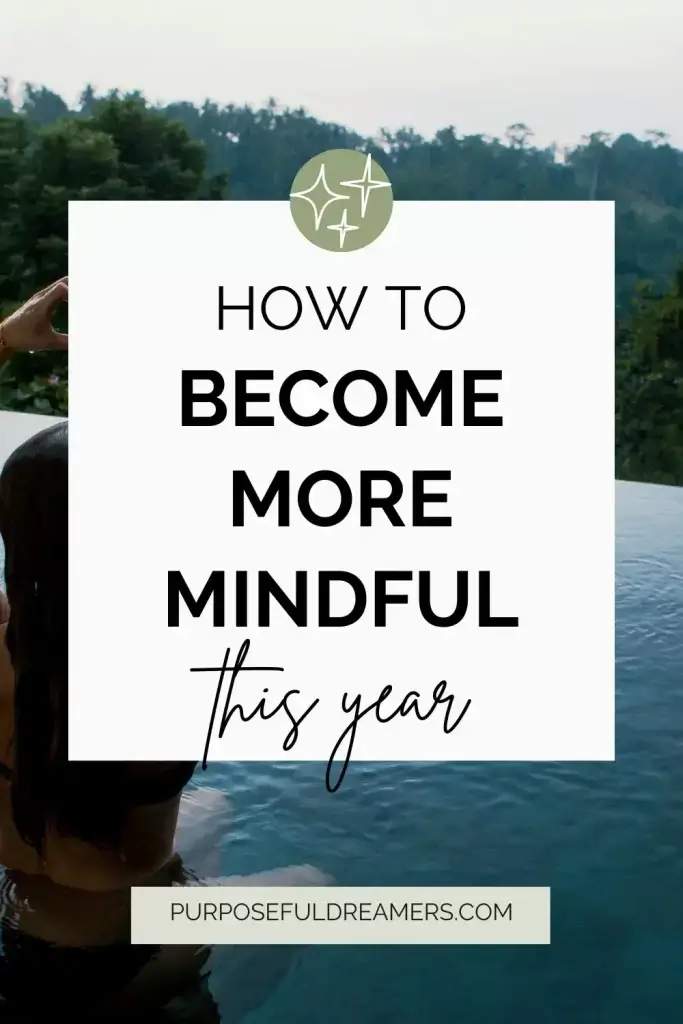Maybe you’re stuck in a boring loop you feel you cannot escape. Life is passing you by – slipping through your fingers – and you barely have any memory of it. But life doesn’t have to be this way! You can change the way you go through days – and it all starts with the right mindfulness exercises 😉
In just a few minutes, you’ll be ready to transform your life by working on what matters the most: your mindset.
Since your mindset shapes your life, if you want to live a more fulfilling life, you need to adopt a mindful approach.
Are you ready to embrace mindfulness in your daily life? Then, let’s get started!
DISCLAIMER: This blog is reader-supported. When you buy through links on this site, I may earn an affiliate commission (which won’t affect your final price). I only promote products that I consider valuable and beneficial for you. If you decide to purchase something – Thank you for buying me a cup of coffee! xx
What Is Mindfulness?
Mindfulness is focusing on the here and now. It’s about letting go of the past and not worrying about the future in order to embrace the present moment.
This moment – right here, right now – is all you have. It’s the only thing that matters. It’s the only thing that’s true and real.
Why stress over what could – or could not – happen in a future moment that’s not even granted?
Or why keep playing in your head old memories, when you have no power over what has been?
You cannot change the past, nor you can predict the future.
The only thing you can do is focus on what’s right here, in front of you, in this moment.
You cannot change your past but learn from it and behave accordingly.
You cannot predict the future, but you can do something now to start living your dream life sooner rather than later.
Mindfulness is a practice that takes time and effort, but the reward is so worth it.
📌 SHORT ON TIME? PIN IT FOR LATER! 📌

The Benefits of Daily Mindfulness
If you’re wondering whether or not you should add mindfulness exercises into your life, here are the most common benefits you’ll experience if you do:
- Lower stress level
- Improved sleep
- Higher focus
- Reduced anxiety and depression
- Better relationships
Now that you know why mindfulness is important, you’ll discover some of the best exercises you can adopt to – slowly but steadily – change your mindset, and so your life!
Sensory Mindfulness Exercises
1. Body scan
It’s a meditation technique that involves focusing attentively on all parts of your body and the sensations you feel in each.
The body and mind are always connected, and they send signals to each other, but we often overlook them.
Where do you feel fear? Usually, you’ll notice a sense of discomfort in your stomach.
When you’re stressed, you’ll feel it in your head.
If you feel anxious, instead, you’ll feel like there’s a weight on your chest.
Your emotions speak. Your body speaks. Are you listening?
Cause if you aren’t, your body will only send you those messages louder and louder.
Before you end up in burnout or having a panic attack, here’s how to do a body scan meditation (BSM) in a few simple steps:
- Find a comfortable and quiet space, where you can sit or lay down undisturbed for some time
- As you close your eyes, start focusing on your breath
- Choose one part of your body where’d you like to direct your focus – your head, your fingertips, or your toes
- Focus on each area for 30 seconds or 1 minute, paying attention to the sensations you feel
- Move onto another part following a certain pattern (either top-down, left-to-right, or their opposites)
- Once you’ve scanned your whole body, slowly and gently come back to your breath
- When you feel ready, open your eyes and come back to your surroundings
This mindfulness technique is ideal if you feel like you’ve lost touch with yourself and want to get a better mind-body connection.
2. Meditation
Moving onto regular meditation, it’s one of the most known mindfulness practices.
Meditating feels overwhelming and complicated to those who are just starting – but I promise, the benefits of it are worth the pain! 😉
The truth is that, once you start meditating regularly, it will impact every other area of your life! Shortly but surely, you’ll:
- Maintain your focus for longer
- Be kinder to others
- Stop negative thoughts
- Sleep better
- Develop a positive mindset
You can meditate even for just a minute or two a day. Or start with five or ten if you feel like it.
What’s important is not the length of your practice, but rather the mindset you have when you close your eyes and focus on the breath.
Look at your thoughts without judging them, or without judging your for having them.
Think of your mind as the blue sky: your thoughts are just clouds passing by.
Start meditating even just for a couple of minutes a day, but make sure you keep up with it.
Consistency is the key to seeing long-lasting changes 😉

3. The 5 senses exercise
It’s a grounding technique that can help you come back to yourself when you’re overthinking or feeling overwhelmed.
How does it work? You must take two minutes out of your day to name:
- Five things you can see
- Four things you can touch
- Three things you can hear
- Two things you can smell
- One thing you can taste
Engaging all five senses is one of the best mindfulness exercises that will instantly bring you back to the present moment.
4. Deep breathing
Maybe you find yourself running short on time during the day to engage in mindfulness.
If that’s the case, deep breathing is the right technique for you 😉
There’s one thing you’re always doing. Constantly. All the time.
It’s so important, as it’s the one thing that keeps you alive – yet how many times do you take it for granted?
As long as you’re breathing, it’s going to be okay.
This mindful technique is simple: it involves you doing what you usually do, with only one minor tweak.
This time, you’re going to focus on your breath.
You’re not allowing for shallow breathing – you’re taking big, deep breaths.
In moments of panic, tension, or anxiety, come back to the most natural thing you can do: breathing.
Observe your lungs expand as you inhale, and see them contract as you exhale.
Do this three or five times, or for as long as you need.
You’re already doing it after all – you’re just not paying attention to it. 😉

Creative Mindfulness Exercises
1. Morning pages
This practice was created by Julia Cameron, in her book The Artist’s Way.
It involves writing, first thing in the morning, and every day, three pages with your stream of consciousness.
You should do this first thing in the morning as your thoughts are the realest.
You haven’t been influenced by the external world yet, so you can get in touch with your most authentic self.
There’s no rule for morning pages. You can write about literally anything – your worries, fears, dreams, goals, and emotions.
Stick to this practice even when you lack inspiration or don’t know what to write about…it’s exactly then that you’ll have the most life-changing breakthroughs! 😉
2. Gratitude journaling
To have a more positive mindset, you should constantly be on the lookout for things to be grateful for.
When you focus on what you lack, you create even more scarcity. On the other hand, if you choose to focus on all you have, you’ll create even more abundance.
There are so many good things happening, every day, all around us – yet we tend to focus on the bad.
Why? Because we’re better at remembering bad things rather than the good stuff.
The truth is that our brains aren’t wired for happiness, but for survival.
So, if you want to stop living in survival mode, you must put an effort into finding the good stuff that’s always happening.
Start a gratitude journal in which, at the end of the day, you list three positive things that happened on that day and for which you’re grateful.
Ending the day on a positive note, through gratitude journaling, is one of the best mindfulness exercises for a more fulfilled life.

3. Coloring
It’s good both to relieve stress and to bring your inner child out!
When you have some free time, why don’t you pick up a good adult coloring book and let your creativity out?
Embrace the silence or play some soft music in the background, and simply allow yourself to be in the moment.
Focus on the drawing and its corners, the shades of your brush pens, and the anxiety and stress wearing off as you engage in this mindful activity.
Not much of an artist? Don’t worry – the next exercise can help too!
4. Self-discovery journaling
It’s more than letting your thoughts out and onto paper. It’s more than writing about your feelings.
Self-discovery journaling is the art of connecting with your deepest self through the power of the right questions.
In this fast-paced world, it’s hard to slow down and take the time to get to know yourself. Doing it, though, will have a major impact on your life.
So, even if the world wants you to keep going – I invite you to set aside some time, grab a pen and paper, and start journaling. Who knows what you’ll discover?
PS. If you don’t know where to start, why not start with these questions? Grab your FREE “50 Journaling Prompts for Self-Discovery”:
5. Daily intentions
Do you wake up late and rush out of the door every day? Do you reach for your phone even before opening your eyes? Are putting yourself to sleep with Netflix playing in the background?
If you’re living like this, you must change something.
One of the best mindfulness exercises you could try is setting an intention for your day.
Setting a daily intention can help you slow down, focus, and prepare for the day ahead.
Start by waking up a little earlier tomorrow and, instead of grabbing your phone, why don’t you come up with an intention for the day?
A daily intention acts like a compass – it shows you the path to follow when you feel lost.
It’s not that complicated, and you don’t need a ton of time to do it.
It can be as simple as choosing to:
- Love yourself
- Honor what your body needs – whether that’s rest, movement, or connection
- Trust your intuition when making hard choices
- Enjoy the company of others
- Stop wasting your time on your phone
What’s your intention for today?
Active Mindfulness Exercises
1. Mindful eating
“It’s not what you eat; it’s how you eat it”
Your mind and body are connected. As a consequence, one won’t perform if the other doesn’t feel good.
Think about it – how can you expect to do great work when you’re sick? And vice versa – how can you expect to have a strong and healthy body when you’re not in a good place mentally?
Mindful eating wants to bring back attention to the mind-body connection by emphasizing the importance of having a good mindset to also have a healthy body.
How can you engage in this simple yet effective mindfulness technique?
- Express gratitude before your meals
- Eat slowly, savoring the different flavors
- Engage all five senses when eating
- Cut off any distractions – so eat screen-free
- Tune in with your hunger and satiety cues
Make your mealtimes a break from the world, rather than letting them turn into another mindless habit you do.

2. Single-tasking
Multitasking is the biggest lie of the 21st century. Who said you’re more productive when you do multiple things all at once?
When you switch tasks in a short amount of time, you’re not doing any good to your brain. Research shows that, while you think multitasking is a time saver, it’s actually making you waste your time!
Why? Because your brain is engaging in a constant “start/stop” pattern when you move from one task to another.
The result? You end up delivering poor work and getting half of the things done. Ugh – it doesn’t feel good, right?
One of the best mindfulness exercises is ditching multitasking to embrace single-tasking.
It’s as simple as it sounds: it’s doing one thing at a time.
So, whenever you eat, just eat.
When you’re with others, be fully present.
If you’re working, do some good work.
If you’re resting, learn to rest without guilt.
Doing one thing at a time is a form of art and rebellion in a world that glorifies speed and productivity.
3. Yoga
The final mindfulness practice you can add to your day is yoga.
Yoga is highly beneficial because it connects movement and breathing.
It can help you get in tune with your body, slowly and gently.
If you’ve never engaged in such a practice, you could start with five or ten minutes of flow following a video on YouTube.
Sometimes, even a quick 5-minute stretch can do wonders for your body and mental health.
Here are three YouTube channels which are perfect if you’re a beginner:
Start your day with a gentle yoga flow or try this form of movement before falling asleep. Trust me – it will help you reconnect with yourself! 😉
📌 LIKED THE ARTICLE? PIN IT FOR LATER! 📌

Conclusion
That’s all for me today!
Mindfulness is not the cure for everything, but most of it! 😉
You can bring more mindfulness into your day by simply following one or more of the mindfulness exercises I mentioned above.
Q: “What’s your favorite mindfulness technique?” – Let me know in a comment! 🙂
Until next time,







